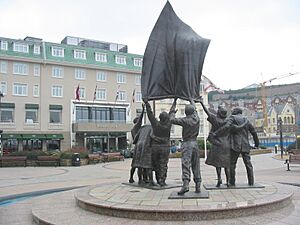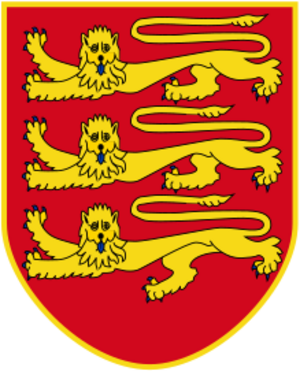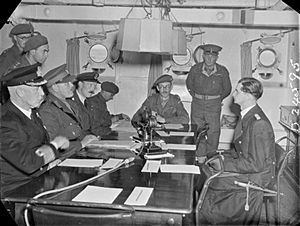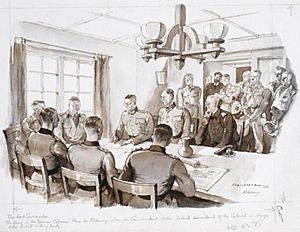Liberation of the German-occupied Channel Islands facts for kids
The Channel Islands are islands that belong to the United Kingdom. During World War II, they were taken over by Nazi Germany. This occupation lasted from June 30, 1940, until May 1945. British forces finally freed the islands after Germany surrendered.
In 1940, the British government decided not to defend the islands. Some people were able to leave and go to England. But many civilians stayed behind. Over 41,101 people remained on Jersey. About 24,429 stayed on Guernsey. On Sark, 470 people remained, and only 18 on Alderney. Island leaders stayed to help look after everyone.
The British government mostly left the islands alone. But in 1944, they attacked German ships and radar units. To prevent people from starving, the British allowed Red Cross parcels to be sent. These parcels arrived during the winter of 1944–45. The islands had to wait until the war in Europe ended in 1945 for freedom.
Contents
Planning the Freedom Mission
Planning to free the Channel Islands began in late 1943. This plan was called Operation Rankin. It looked at three ways the islands might be freed.
- Case A: If Germany was weak and had few soldiers left. A small attack might work.
- Case B: If the Germans left the islands on their own. British forces would then move in.
- Case C: If all German forces surrendered completely. This was thought to be the most likely option.
A plan for Operation Rankin C was made. It said that only 725 officers and men would be enough. They would need ships to bring food and medicine. They also needed small boats for landing supplies.
Gathering Information
In 1943, there was not much information about the Channel Islands. New photos from the air were needed. There were no Allied radios on the islands. This made it hard to know what was happening.
Experts thought there were about 23,800 German soldiers. They believed surrender would only happen if the Germans lost hope or ran out of food. About 65,000 civilians were estimated to be on the islands. This included 42,000 in Jersey and 23,000 in Guernsey.
More aerial photos were taken. People who had escaped the islands were also interviewed. This helped the Allies learn more.
Detailed Plans for Liberation
In early 1944, Brigadier Alfred Ernest Snow was put in charge. His group was called Task Force 135. The plan was later renamed Operation Nestegg on August 11, 1944. Plymouth was chosen as the starting port for the mission.
In August 1944, Germany offered to let all Channel Island civilians leave. This offer was made through the Swiss Red Cross. The British government thought about it. But the offer was turned down.
The planners set up a special timetable. "W-Day" was the warning day when the mission would start. "C-Day" was the first day of landing. This helped them prepare everything.
It was important to include islanders in the planning. Their local knowledge was very helpful. People who escaped the islands also gave important information.
Landing on both Jersey and Guernsey on the same day needed many soldiers. Three battalions of 700 men each were needed. Engineers were also included. Good landing beaches were chosen. These included St Aubin's Bay in Jersey.
A special unit, No 20 Civil Affairs Unit, handled supplies. They planned to bring 200 tons of food, clothes, and medicine. They also planned for everything else the islands would need. This included things like pots, pans, and even toilet paper.
British money would be brought to the islands. People could exchange their German money for British pounds. Free "treats" like tobacco, chocolate, and tea were also planned.
Longer-term plans were made too. These included removing German prisoners and clearing mines. Enough food would be brought to feed civilians for three months.
The British were not in a hurry to free the islands. The German soldiers there were cut off. They were like prisoners already. Many British troops were needed for fighting in Europe.
Attempts to Surrender Early
In September 1944, British planes dropped leaflets over the islands. These leaflets were printed in German. On September 22, a British ship tried to meet a German ship. This was near Guernsey. The British ship went into St Peter Port harbour under a white flag. But the Germans refused to talk about surrender.
Around this time, the Allies allowed the International Committee of the Red Cross to send a ship. This ship, the Vega, brought Red Cross parcels. It helped prevent starvation. The first ship arrived in mid-December.
More leaflets were dropped. But the German soldiers could not desert. So, these attempts did not work.
Practice Missions
In December 1944, a practice mission for Operation Nestegg took place. About 6,100 troops gathered. Supplies were loaded onto vehicles and ships. The Jersey force landed in Paignton. The Guernsey force landed in Brixham. This practice helped them find problems. For example, they found a shortage of cooks. They used these lessons to improve the plan.
A second practice happened in February 1945. It went smoothly. A third practice was planned for May but was cancelled.
Task Force 135
About 6,000 soldiers and naval forces were part of Task Force 135. This included:
|
|
- Other support units like Medical, Postal, Police, and Intelligence.
- Ships from British, American, Canadian, and other Allied Navies.
The Final Days Before Freedom
The landing plans for Guernsey (Prophet) and Jersey (Moslem) were given the "stand to" warning on May 3, 1945. This made May 4 W-Day. Vehicles were marked with special badges. Equipment and supplies started moving from storage.
On May 8, 1945, Europe celebrated the end of the war. Vehicles for the mission were being loaded. News reporters came aboard the ships.
On the islands, people were very excited. Authorities tried to stop them from putting up flags. They did not want to make the Germans angry. The Germans were very worried about their future.
On May 7, the Bailiff of Jersey helped release 30 political prisoners. The British also sent a message to the German commander. It said ships would arrive soon to accept their surrender. The German commander replied that he only took orders from his own command.
Everything changed on May 8. The Germans released all British, French, and American prisoners. Flags and decorations appeared in the streets. Radios, which had been banned, were brought out. People connected them to loudspeakers.
Crowds cheered and celebrated. Newspapers announced that peace had arrived. But the British landing force was not there yet.
Late on May 7, the British tried again by radio. The German commander confirmed that British ships would not be fired upon. Two British destroyers, HMS Beagle and HMS Bulldog, sailed on May 8. They carried an advance party called "Omelette."
They arrived off Guernsey at 2 PM. A German minesweeper met them. A German officer came aboard HMS Bulldog. He said he could only talk about surrender, not sign it. The British gave him the surrender terms. The British ships then left.
Freedom Day: May 9
The Germans agreed to a meeting at midnight. The ships returned to Guernsey. A German minesweeper met HMS Bulldog. Generalmajor Siegfried Heine came aboard. He was asked if he would accept unconditional surrender. He replied "Ja" (Yes). The ships then sailed slowly to St Peter Port.
Eight copies of the surrender terms were signed. This happened on the ship's deck. It was done politely. At 7:15 AM, HMS Bulldog anchored off St Peter Port.
All German flags were to be lowered. German ships would pick up British troops. The first "Omelette" force landed at 7:50 AM. It had four officers and 21 men. They were greeted by a town decorated in red, white, and blue. Thousands of cheering islanders sang patriotic songs. Lt-Col Stoneman set up his headquarters. At 11:00 AM, he met the Bailiff of Guernsey. A Union Flag was raised.
Brigadier Snow went to Jersey on HMS Beagle. HMS Bulldog stayed off St Peter Port. A local fishing boat visited HMS Bulldog. Sailors traded German souvenirs for chocolate and cigarettes.
HMS Beagle arrived at St Helier on Jersey at 10:00 AM. They had another set of surrender documents. This was done because of the rivalry between the two islands. Two naval officers were met by the harbourmaster. They raised the Union Flag from his office window. They also raised it on the flagstaff of the Pomme D'Or Hotel.
The Bailiff of Jersey, Alexander Coutanche, had already received a phone call from Guernsey. At 10:00 AM, HMS Beagle arrived. A German tug boat came out to meet them. But the Jersey commander was not on board. It was noon before Generalmajor Rudolf Wulf came out. He was with the Bailiff of Jersey. The Germans signed the surrender documents at 2:00 PM. The first Jersey "Omelette" troops landed soon after. These were five signallers.
RAF planes flew over at 1:00 PM. The people of Jersey were told to be in Royal Square at 2 PM. But the event was delayed. At 2:30 PM, the first "Omelette" men landed. They marched to the Pomme d’Or Hotel. A huge crowd waited for them. The German swastika flag was removed. A Union Flag was hung from the hotel balcony. This hotel became the Task Force 135 HQ.
The Germans were told to move all troops away from St Helier. This was except for the hospital and guards. The flag over Fort Regent changed to the Union Flag at 5:00 PM. British soldiers gave sweets to children. They noticed how thin the islanders looked.
A large landing craft arrived at 5:00 PM. It carried 200 more Jersey "Omelette" personnel. Canadian planes flew over St Helier. The troops split into small groups. They took control of the town.
The Red Cross ship, SS Vega, was in the harbour. It had just arrived with more parcels.
The main part of the Guernsey "Omelette" landed at 2:15 PM. Many more people came to town to see them. Church bells were ringing. British soldiers were given flowers. The Germans started clearing the airport. They also disconnected sea minefields. German officers were assigned to help the British HQ.
Both islands were told the main force would arrive on Saturday, May 12. There would be special ceremonies then.
HMS Beagle sailed back to Guernsey. HMS Bulldog sailed back to Plymouth with Brigadier Snow.
On May 9, some young women were treated roughly by locals. These women had been seen with German soldiers. Other people thought to be collaborators were also targeted. A few people, including Germans, were arrested. There were some injuries from children playing with German guns.
The British Post Office repeater station in Jersey might have been the first place freed. A GPO lineman, Mr. Warder, took over the building. He told the German officer in charge that he was taking it over for the British Post Office.
May 10: More Arrivals
Loading of vehicles, equipment, and men continued. Small ships carrying coal and fuel joined the fleet. Ten large landing ships (LSTs) were in the first group.
In Jersey, Lt-Col Robinson marched through town with British troops. A crowd gathered. They arrived in Royal Square. The Union Flag was raised. A Boys Brigade band played "God Save the King." That afternoon, a ceremony thanked the Red Cross officials on the SS Vega. In the evening, a show was held at the Opera House.
Minesweepers cleared channels across the English Channel. No mines were found.
The number of German soldiers was confirmed. There were 26,909 in total. Jersey had 11,671, Guernsey 11,755, Alderney 3,202, and Sark 281.
Allied prisoners of war had already been released. They joined the celebrations. They were gathered to return to England. Church services were held to mark the liberation.
There were more attacks on girls accused of being friendly with Germans. Some people tried to protect them. One Jersey woman and her son were jailed for their own safety. Newspapers, which had been short of paper, continued printing.
The liberation of Sark, called Operation Marble, happened on this day. It was earlier than planned. This was because of reports of unrest among the Germans. A large fire was seen. A German ship was taken. It sailed to Sark with British troops. They met Sibyl Hathaway, the Dame of Sark. She explained the bonfire was a celebration. Surrender documents were signed. The Germans were told to give up weapons and clear mines. The ship returned to Guernsey. The Dame of Sark was left in charge of the German soldiers until May 17.
May 11: Preparing for the Main Force
On the islands, work began to clear beaches and slipways. They needed to be ready for the landing craft.
The public was warned not to steal or enter minefields. They were told to stay away from landing areas. This was so vehicles could land safely.
In Jersey, officials met with British officers. New laws were approved. Services of thanksgiving were held in churches.
Reports were quickly made about the islands' situation. These covered fuel, food, health, and postal services. German secret police were rounded up.
A boat was sent to Sark to pick up the Dame of Sark. She had lunch on HMS Beagle.
The main group of ships for Guernsey sailed from Plymouth. It had 13 ships. The Jersey group followed 15 minutes later. All ships were told to stay far from Alderney. It was not known if Alderney had surrendered.
C-Day: May 12
The ships for Jersey anchored off St Helier at 7:00 AM. The ships for Guernsey anchored off St Peter Port at 7:15 AM. German troops were kept in their barracks.
In Guernsey, landings happened at L’Ancresse bay and St Peter Port. At 8:30 AM, the first landing craft docked. Their goal was to secure Castle Cornet. This was a German strongpoint. More landing craft came ashore. They secured German defenses in the harbour. Not many civilians were seen at first. But soon, people flocked into town. They were shouting and cheering. British military police kept them clear of the piers.
People were amazed to see a large landing ship enter the harbour. Troops moved through town. They secured buildings that were German headquarters.
More troops landed. This included MI5 officers, press, and engineers. Soldiers focused on their military goals. They moved away from town. They secured Fort George and other areas. Bicycles helped troops move quickly.
Another official surrender happened at 11:00 AM. Brigadier Snow accepted the German surrender at the Crown Hotel. In town, people were amazed to see DUKW amphibious vehicles. These vehicles could swim ashore and drive on land. Then, large trucks drove out of the landing ship.
Brigadier Snow paraded through town. He was with important people and a band. They went to Elizabeth College at 2:00 PM. About 2,500 people watched the Union Flag being raised. A message from King George VI was read.
Most landing ships sailed to L’Ancresse bay. Unloading continued at night.
In Jersey, Operation Moslem followed a similar plan. They secured Elizabeth Castle. They created a landing area in St Helier. They secured German gun positions. Mines designed to destroy the harbour were made safe. Planes watched overhead. More troops landed to secure St Helier. They also secured electricity and water facilities.
DUKWs started landing supplies. Landing craft docked. St Aubin's bay was cleared for large landing ships. Beach obstacles were destroyed. Jersey Scouts helped as messengers. Sadly, a nine-year-old girl was killed. She was hit by a motorcycle.
Brigadier Snow left Guernsey and sailed to Jersey. At 6:00 PM, he took part in a historic event. He read a proclamation in Royal Square. Speeches and the King's message were read. The band played the National Anthem. Many people sang along.
May 13: Unloading and Prisoners
Unloading continued on both islands. By the end of the day, 3,427 men and 299 vehicles were unloaded in Guernsey. St Sampson's harbour also started operating. German soldiers, now prisoners of war, helped with the heavy work. Most weapons had been surrendered.
In Jersey, St Aubin's bay was opened for large landing ships. Vehicles included ambulances, cranes, and bulldozers. Lorries brought £477,000 in money to the island banks. Many locals watched. They had never seen such ships.
Empty landing ships were loaded with prisoners. About 800 per ship. The German soldiers were very hungry. They were almost as starved as the islanders.
May 14: Back to Normal
Unloading continued in St Aubin's bay. Road traffic went back to driving on the left side. Postal services opened. Free postcards were given out. People could send messages to relatives overseas. Clocks changed to British time.
Germans worked well with the British forces. Locals watched German soldiers leave the island. About 10,000 prisoners were expected to leave on the returning ships.
The British Home Secretary, Herbert Morrison, arrived in Jersey. He was with other government ministers.
May 15: Official Visits and Money
A formal meeting took place in Jersey. Morrison congratulated the island for staying British. He explained that the British government could not have helped in 1940. Any fighting would have caused many deaths.
Orders were given to change German money back to British money. The exchange rate was 9.36 German marks to £1. This rate was used until May 23. Cash withdrawals from banks were limited to £5 a week. Banks closed for two days. This was to combine accounts.
Loading German prisoners continued. Some German engineers and naval staff stayed. They continued to work with the British. German troops were also amazed by the strange landing ships.
May 16: Alderney Surrenders
German troops in Alderney surrendered on this date. This was to Force 135. (The German prisoners were not removed until May 20. People were not allowed to return until December. The island needed to be cleared first.)
On the islands, special police guarded supply dumps. Loudspeakers were put up in St Helier. Food distributions were made to civilians. These included tea, chocolate, and sugar. Daily calorie intake increased from about 1,000. Red Cross parcels continued to be given out.
Houses used by Germans were inspected. Many were in terrible condition. They needed cleaning and disinfecting. German hospitals were also cleared.
Police courts opened. A few civilians were charged with theft. Newspapers continued printing. Supplies would arrive soon.
Mines were being removed. This dangerous work continued until August. About 65,982 mines were removed. This caused some German deaths and injuries. Over 5,689 beach obstacles were also removed. Weapons and shells needed to be collected safely.
Operation Merit started. Brigadier Snow sailed to Alderney. He was with officers and the press. They landed at Braye Harbour. They met the island commander. They discussed surrender details. Officers began questioning German workers and prison officials. They wanted to learn about the Alderney camps. Stories of brutality were common. An investigation would be held.
After the Liberation
The Channel Islands were now free. The clean-up and rebuilding began. Military rule lasted until August 25, 1945. New leaders were then appointed.
The Germans had not destroyed many facilities. But there were still many problems. People needed to be paid for damaged homes and businesses. There were questions about people who profited from the black market. Some people wondered if others should be punished or praised. The islands needed to rebuild their tourism. They also had huge public debts.
Some British soldiers settled on the islands. For example, Eric Walker became the bomb disposal officer for Jersey.
Other problems arose. Tens of thousands of civilians had left the islands. Many returned. Some children had grown up. They realized their parents did not know them.
Some people never recovered from the experience. They were physically and mentally sick. Anger and fear affected some for decades. Rationing continued until the mid-1950s.
The last Germans left on May 20. This was except for about 1,500 in Guernsey, 1,300 in Jersey, and 500 in Alderney. These stayed to help with clearing up. On May 23, a small group of German soldiers was found on a reef. They had been forgotten and wanted to surrender.
The King and Queen visited Jersey and Guernsey on June 7. They ate simple food, like tinned steak and kidney pie. This was the same food German prisoners and British soldiers ate. The first people who had left the islands started to return on June 25. Alderney residents had to wait until December. Their island needed to be safe first. About 35,000 mines had to be removed. This caused injuries. One young soldier, Sapper George Onions, was killed. Houses had been badly damaged. In December, many people received awards for their service.
Castle Cornet was given to the people of Guernsey in 1947. This showed thanks for their loyalty during the wars.
Remembering Freedom Day
Liberation Day (Channel Islands) The way liberation is remembered has changed. May 9 is still a public holiday in Guernsey and Jersey. For some, it is a day to party. For others, it is a day of quiet remembrance.
See also
- German occupation of the Channel Islands
- Evacuation of civilians from the Channel Islands in 1940
- Deportations from the German-occupied Channel Islands
- Civilian life under the German occupation of the Channel Islands
- Living with the enemy in the German-occupied Channel Islands
Images for kids








